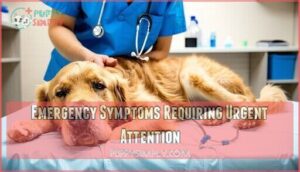This site is supported by our readers. We may earn a commission, at no cost to you, if you purchase through links.
 When it comes to vet visits, your dog’s age tells you everything. Puppies are basically tiny health mysteries that need solving every 2-4 weeks until they hit 16 weeks – that’s when they get their vaccination series and you make sure they’re growing like they should.
When it comes to vet visits, your dog’s age tells you everything. Puppies are basically tiny health mysteries that need solving every 2-4 weeks until they hit 16 weeks – that’s when they get their vaccination series and you make sure they’re growing like they should.
Once they’re adults, an annual checkup catches problems before they become expensive nightmares.
Senior dogs? They age faster than we’d like, so twice-yearly visits help you stay ahead of the health curveballs that come with gray muzzles.
Your dog’s breed, lifestyle, and existing health conditions also influence visit frequency. Regular preventive care prevents costly emergencies and keeps your furry friend healthy. Think of it as routine maintenance for your car, but way more rewarding when they wag their tail afterward.
Understanding the specific signs that warrant immediate attention can save your dog’s life.
Table Of Contents
- Key Takeaways
- How Often Should I Take My Dog to The Vet?
- How Often Should Puppies Visit The Vet?
- How Often Should Adult Dogs Visit The Vet?
- Do Senior Dogs Need More Frequent Vet Visits?
- When Does My Dog Need Immediate Vet Care?
- What Does Pet Insurance Cover for Vet Visits?
- Why Regular Vet Visits Are Essential for Dogs
- Frequently Asked Questions (FAQs)
- What are some common signs of poisoning in dogs and how should I handle it?
- What does a comprehensive physical examination for dogs typically include?
- How can I prevent obesity and dental issues in my adult dog?
- How much do emergency vet visits typically cost?
- Can I use telemedicine for my dogs health?
- What vaccinations does my dog need annually?
- How do I find a reliable veterinarian?
- Should I get a second opinion for diagnosis?
Key Takeaways
- Schedule visits based on your dog’s age: You’ll need checkups every 2-4 weeks for puppies until 16 weeks old, annual exams for adult dogs, and twice-yearly visits for seniors over 7 years.
- Don’t wait for emergencies to seek care: Recognize warning signs like difficulty breathing, severe vomiting, sudden collapse, or behavioral changes that require immediate veterinary attention.
- Preventive care saves money and catches problems early: Regular checkups help detect health issues before they become serious and expensive, making treatment more effective and less costly.
- Your dog’s breed, lifestyle, and health status affect visit frequency: You’ll need more frequent visits if your dog has chronic conditions, high genetic disease risks, or exposure to environmental hazards like tick-borne diseases.
How Often Should I Take My Dog to The Vet?
How often should you take your dog to the vet? It depends on their age and current health. Puppies need frequent checkups—every 2-4 weeks until they hit 16 weeks old. Adult dogs do well with annual wellness exams, while senior dogs should see the vet twice a year since health issues can develop more quickly as they age.
Your dog’s health status, lifestyle factors, and any chronic conditions will influence how frequently you should book appointments with your veterinarian.
Recommended Vet Visit Schedule by Age
Your dog’s vet visit schedule depends on their life stage. Puppies need frequent checkups every 2-4 weeks until 16 weeks for vaccinations and growth monitoring.
Adult dogs require annual checkups to maintain health and catch issues early.
Senior dogs benefit from biannual visits as age-related conditions develop more quickly, requiring closer monitoring.
Factors That Influence Visit Frequency
Age isn’t the only thing that dictates your dog’s vet schedule. Several other factors play into how often your furry friend should get checked out.
- Breed predispositions – Purebred dogs face higher genetic disease risks, requiring more frequent monitoring for breed-specific conditions than mixed breeds.
- Lifestyle factors – Active dogs exposed to boarding facilities, dog parks, or wilderness areas need additional preventive care and vaccinations.
- Environmental risks – Dogs in regions with tick-borne diseases, heartworm, or other endemic threats require specific preventive protocols and screenings.
- Owner awareness – Your ability to recognize subtle health changes affects visit frequency, with attentive owners catching issues early. Adult dogs should visit the vet regularly for routine wellness exams.
- Financial constraints – Budget limitations shouldn’t prevent basic care; discuss payment plans or prioritize essential preventive services with your vet.
Common Myths About Vet Visits
Misinformation around veterinary care can put your pet at risk. Many owners believe breed-specific myths or turn to online diagnoses instead of professional consultation. Let’s tackle dangerous misconceptions that delay preventive care.
| Myth | Truth |
|---|---|
| Healthy dogs don’t need annual vet visits | Preventive screenings catch problems early |
| Vet visit costs are always expensive | Regular checkups prevent costly emergencies |
| Vaccine hesitancy protects from "chemicals" | Vaccines prevent fatal diseases safely |
| Wait-and-see approach works fine | Early treatment improves outcomes dramatically |
How Often Should Puppies Visit The Vet?
Your puppy needs frequent veterinary visits during their first few months, approximately every 2-4 weeks until they reach 16 weeks of age.
During these visits, your vet will keep your pup on track with their vaccination timeline, check that they’re growing well, and create health records you’ll rely on for years to come.
Initial Health Screenings and Vaccinations
Getting your new puppy off to a healthy start means booking that first vet visit for initial screenings and setting up their vaccination timeline.
Your pup should get their first shots between six and eight weeks old – this protects them from serious diseases while giving your vet a chance to check for any birth defects and discuss whether microchipping makes sense for your situation.
These puppy checkups guarantee proper deworming protocols, promoting healthy socialization during critical development phases through thorough puppy vaccines.
Booster Shots and Follow-up Appointments
After your puppy’s initial vaccination, they’ll need booster shots at regular intervals to maintain immunity. Boosters are given every 2–4 weeks until the puppy is 16–20 weeks old to guarantee protection.
Your vaccination schedule should include:
- Core vaccine boosters every 2-4 weeks until 16 weeks
- Annual appointment reminders to track booster effectiveness
- Titers testing to check immunity levels before boosters
Watch for adverse reactions after each vet visit.
Monitoring Growth and Development
During puppy visits, vets track growth milestones by weighing your pup and measuring their development against breed-specific charts. These assessments help identify potential developmental delays, nutritional needs adjustments, and behavioral changes that could signal health issues.
Your vet monitors socialization impact alongside the puppy vaccination schedule to help your furry friend develop properly alongside their puppy health and vaccinations routine.
How Often Should Adult Dogs Visit The Vet?
Once your dog reaches adulthood, you’ll need to schedule annual wellness exams to maintain their health and catch potential issues early.
Your vet will cover the essentials during these visits – updating core vaccinations, running preventive screenings, and doing a head-to-tail examination to spot any health changes before they turn into bigger problems.
Annual Wellness Exams and Core Vaccines
Once your adult dog hits that one-year mark, annual wellness exams become their health safety net. Core vaccines like DHPP protect against distemper, hepatitis, parvovirus, and parainfluenza, while rabies boosters maintain legal compliance.
Your vet’s thorough exam components include weight checks, heart monitoring, and blood work. This preventative care approach catches problems early, making cost analysis favorable compared to emergency treatments.
Preventive Screenings and Dental Care
Beyond vaccinations, preventive veterinary care includes screenings that can catch problems before they become expensive headaches. Your vet’s routine exam should include:
- Dental Prophylaxis – Professional cleaning prevents periodontal disease
- Cancer Screenings – Physical exams detect lumps or abnormalities
- Parasite Prevention – Heartworm prevention and fecal testing protect health
- Genetic Testing – Breed-specific screenings identify inherited conditions early
Detecting Early Signs of Illness
Beyond preventive care, your dog’s routine exam functions as a detective’s magnifying glass for spotting trouble early. Subtle Symptom Recognition during these visits catches underlying health issues before they become serious problems. Behavioral Change Analysis helps vets identify when your normally playful pup seems off.
| Warning Sign | What to Watch | When to Call Vet |
|---|---|---|
| Appetite/Thirst Shifts | Eating less, drinking more | 2+ days of changes |
| Coat/Skin Alterations | Dull fur, excessive scratching | New or worsening symptoms |
| Early Lameness Detection | Favoring one leg, stiffness | Any limping observed |
| Energy Changes | Lethargy, restlessness | Sudden personality shifts |
| Bathroom Habits | Accidents, straining | 24+ hours of issues |
Annual checkups give your vet baseline measurements to compare against future visits, making dog illness detection more accurate.
Do Senior Dogs Need More Frequent Vet Visits?
Once your dog hits seven, you’ll want to bump up those vet visits to twice a year rather than the usual annual checkup.
Things can change quickly in older dogs. Those twice-yearly appointments help catch problems like joint pain or kidney trouble before they become serious issues that could really affect how your dog feels day to day.
Biannual Checkups for Aging Dogs
Scheduling Senior Dog Checkups twice yearly catches health issues before they snowball into bigger problems. Senior screenings help monitor arthritis management, cognitive decline, and medication reviews.
Your vet can adjust palliative care plans during these biannual visits, helping your furry companion’s golden years remain comfortable.
Senior dog health concerns develop quietly, but regular senior dog health management prevents surprises. These visits often include geriatric screening tests to catch early warning signs.
Additional Tests and Screenings for Seniors
Extensive testing becomes essential in senior dog care. Senior bloodwork should include complete blood counts and biochemistry panels every six months to monitor kidney function and detect early disease signs.
Your vet might recommend additional screenings like cancer detection tests, arthritis screening, and cognitive decline assessments during senior dog checkups.
Managing Chronic and Age-related Conditions
Managing chronic conditions in senior dogs requires ongoing collaboration with your veterinarian. Arthritis, diabetes, and kidney disease need regular medication adjustments and pain management strategies.
Your vet will monitor blood work, adjust treatments, and help maintain your senior dog’s quality of life through specific senior dog health management plans that address specific senior dog health concerns during routine vet appointments.
When Does My Dog Need Immediate Vet Care?
Regular vet visits are important, but some symptoms can’t wait until your next scheduled appointment and need immediate attention.
You’ll need to recognize emergency warning signs, such as difficulty breathing, severe vomiting, or sudden collapse, that can’t wait for your next appointment.
Sudden Changes in Behavior or Appetite
When your dog suddenly refuses their favorite meal or becomes unusually withdrawn, these Behavioral Red Flags signal Dog health issues requiring immediate Vet Visits.
Appetite Loss Causes and Lethargy Indicators, along with Aggression Signs or Increased Thirst, represent Pet health concerns warranting Veterinary Guidance to address Canine Health Issues promptly.
Emergency Symptoms Requiring Urgent Attention
Watch for these red flags that demand immediate Emergency Vet care. Severe Bleeding that won’t stop within five minutes, Breathing Difficulty, Seizure Activity, or Sudden Collapse need instant action.
Unconsciousness and Toxic Ingestion symptoms signal critical Canine Health Issues.
Don’t hesitate—Emergency Veterinary Care saves lives when Pet Health Concerns escalate rapidly.
What to Do in Case of Suspected Poisoning
Time is critical when poisoning strikes your furry friend. Immediately identify toxins by checking what they consumed, then call poison control or your emergency vet before taking action.
Never induce vomiting unless specifically instructed—some substances cause more damage coming back up. Your vet may administer activated charcoal or provide supportive care based on the specific toxin involved.
What Does Pet Insurance Cover for Vet Visits?
Here’s the thing about pet insurance – it can slash what you pay at the vet, but not all policies are created equal. Basic coverage handles the big stuff like accidents and sudden illnesses.
Want more? Premium plans often throw in your regular checkups, shots, and all those preventive care visits that add up over time.
Accident and Illness Coverage
Pet insurance accident and illness coverage protects you when unexpected veterinary care strikes. This Emergency Coverage addresses bite wounds, broken bones, chronic conditions like cancer and diabetes, plus breed-specific illnesses.
Most plans cover diagnostic tests, medications, and surgery costs. However, policy exclusions apply to pre-existing conditions and certain genetic predispositions, so review coverage details carefully before choosing your pet insurance plan.
Optional Wellness and Routine Care Plans
Many pet owners supplement their basic coverage with wellness package tiers that cover routine preventative veterinary care. These preventative care add-ons generally include annual wellness exams, vaccinations, and dental cleanings.
Some insurers offer flexible reimbursement limits ranging from $250 to $650 annually. Modern wellness plans may include telehealth options and subscription vet care for ongoing assistance.
Understanding Deductibles and Reimbursement
Deductible options range from $0 to $1,000, affecting your premium costs. Higher deductibles mean lower monthly payments but more out-of-pocket expenses per claim.
Reimbursement rates generally span 70-90% of covered costs after you meet your deductible.
Waiting periods for illness coverage usually last 14 days, while accidents often have no waiting period.
Understanding policy exclusions helps avoid claim submission surprises.
Why Regular Vet Visits Are Essential for Dogs
Dogs hide pain and illness instinctively, which means problems can develop without obvious warning signs.
Dogs instinctively mask their pain and illness, making regular vet checkups essential for catching hidden health problems before they escalate
Regular vet checkups become your safety net here, catching issues while they’re still manageable. These routine visits let veterinarians spot problems early, when treatment works best and costs less.
Preventing Common Canine Diseases
Staying ahead of health problems keeps your dog healthier and saves you money down the road. Regular vet visits catch issues early, when they’re easier and cheaper to treat.
Your vet will keep your dog current on shots for rabies, distemper, and parvo—diseases that can be deadly but are completely preventable. They’ll also set up a prevention plan for parasites like fleas, ticks, and heartworms that can make your dog miserable or seriously sick.
- Vaccination schedules tailored to your dog’s lifestyle and risk factors
- Complete parasite prevention covering heartworm, fleas, and ticks
- Dental checkups to catch gum disease before it becomes painful
- Breed-specific screenings for conditions like hip dysplasia
- Nutrition advice based on your dog’s age, size, and energy level
Importance of Early Detection and Treatment
Catching health problems before they snowball can mean the difference between simple treatment and complex interventions. Early detection through annual exams dramatically improves treatment efficacy while reducing suffering for your furry friend.
Early Detection Benefits Delayed Treatment Consequences
When vets spot issues during routine vet appointments, they can address problems before they become serious. This preventative veterinary care approach transforms manageable concerns into success stories rather than heartbreaking battles.
Tips for Maintaining Your Dog’s Overall Health
Between annual exams, you can foster your dog’s health through proper nutrition and diet suited to their age and size.
Provide daily exercise needs while incorporating mental stimulation activities.
Practice home dental care with regular brushing, maintain parasite prevention protocols, and monitor changes in behavior.
These preventative veterinary care habits complement adult dog checkups and wellness exams perfectly.
Frequently Asked Questions (FAQs)
What are some common signs of poisoning in dogs and how should I handle it?
Over 200,000 poisoning cases happen yearly in pets. Watch for vomiting, diarrhea, seizures, and tremors .
Emergency signs include collapse, excessive drooling, and breathing problems . Contact your vet immediately if you notice these symptoms.
What does a comprehensive physical examination for dogs typically include?
A thorough vet exam includes checking your dog’s eyes, ears, mouth, heart, lungs, abdomen, skin, joints, and lymph nodes. Your vet’ll also assess weight, temperature, and discuss behavior changes.
How can I prevent obesity and dental issues in my adult dog?
You’ll prevent obesity by controlling portions, choosing quality food, and including daily exercise. For dental health, brush teeth regularly, provide dental chews, and schedule professional cleanings.
How much do emergency vet visits typically cost?
Emergency vet visits can range from $250 to $8,000 , with most basic same-day emergencies costing a few hundred dollars. Complex cases requiring extensive diagnostics and treatment can easily reach several thousand dollars.
Can I use telemedicine for my dogs health?
Can your vet "see" through the screen? Yes, telemedicine works for many dog health concerns.
Most states require you to have an established relationship with a vet for your pet to be diagnosed and treated via telehealth, so you’ll need a recent in-person exam first.
What vaccinations does my dog need annually?
Your dog needs core vaccines including rabies, distemper, parvovirus, and hepatitis annually. Non-core vaccines like Bordetella may be needed based on lifestyle and exposure risks.
How do I find a reliable veterinarian?
Ask friends and family for recommendations, read online reviews, and schedule a meet-and-greet visit. Look for board certification, clean facilities, and staff who communicate clearly about your pet’s needs.
Should I get a second opinion for diagnosis?
When you’re facing a serious diagnosis or expensive treatment, seeking a second opinion can provide valuable peace of mind and potentially reveal alternative treatment options that better suit your situation.
Think of your dog’s health like having a good roadmap—regular vet visits are your best shot at keeping them healthy for as long as possible.
Your dog’s health journey mirrors a compass guiding you through uncharted territory—regular veterinary care points you toward their longest, healthiest life possible.
Establishing how often should I take my dog to the vet depends on age, health status, and individual needs. Puppies require frequent visits for vaccinations, adults benefit from annual checkups, and seniors need biannual monitoring.
Don’t wait for emergencies to strike. Preventive care catches problems early, saves money, and ensures your loyal companion stays by your side for years to come.
- https://vcahospitals.com/know-your-pet/wellness-examination-in-dogs
- https://wsava.org/wp-content/uploads/2020/01/WSAVA-Vaccination-Guidelines-2015.pdf
- https://www.healthforanimals.org/wp-content/uploads/2022/07/Global-State-of-Pet-Care.pdf
- https://www.avma.org/javma-news/2013-02-01/vital-statistics
- https://www.deltonavet.com/healthy-pet-services/what-is-a-comprehensive-exam-for-dogs-5-common-conditions-detected/
















